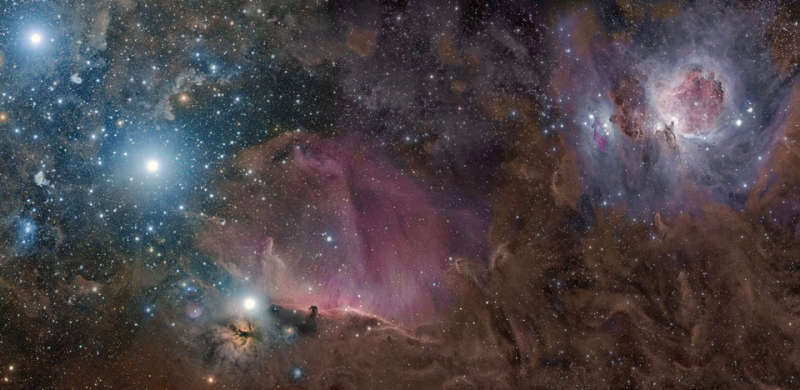Credit & Copyright: Rogelio Bernal Andreo
(Deep Sky Colors)
Explanation:
The constellation of Orion holds much more than three stars in a row.
A deep exposure shows everything from dark nebula to star clusters,
all embedded in an extended
patch of
gaseous wisps in the greater
Orion
Molecular
Cloud
Complex.
The brightest three stars
on the far left are indeed the
famous three stars that make up the
belt of Orion.
Just below Alnitak, the lowest of the
three belt stars, is the
Flame Nebula, glowing with
excited hydrogen gas and immersed in filaments of dark brown dust.
Below the frame center and just to the right of
Alnitak lies the
Horsehead Nebula, a
dark indentation of
dense dust that has perhaps the most recognized nebular
shapes on the sky.
On the upper right lies
M42, the
Orion Nebula,
an energetic caldron of tumultuous gas,
visible to the unaided eye,
that is giving birth to a
new open cluster of stars.
Immediately to the left of
M42
is a prominent bluish reflection nebula sometimes called the
Running Man that houses many bright
blue stars.
The above
image, a digitally stitched composite taken over several nights, covers an area
with objects that are roughly 1,500
light years away and spans about 75 light years.
1999 2000 2001 2002 2003 2004 2005 2006 2007 2008 2009 2010 2011 2012 2013 2014 2015 2016 2017 2018 2019 2020 2021 2022 2023 2024 2025 |
Январь Февраль Март Апрель Май Июнь Июль Август Сентябрь Октябрь Ноябрь Декабрь |
NASA Web Site Statements, Warnings, and Disclaimers
NASA Official: Jay Norris. Specific rights apply.
A service of: LHEA at NASA / GSFC
& Michigan Tech. U.
|
Публикации с ключевыми словами:
Orion Nebula - dust - star formation - Туманность Ориона - звездообразование
Публикации со словами: Orion Nebula - dust - star formation - Туманность Ориона - звездообразование | |
См. также:
Все публикации на ту же тему >> | |
